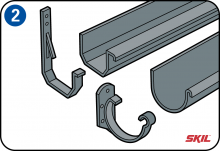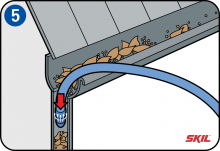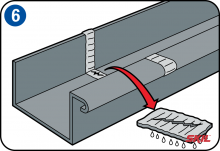-
Regular checking
In essence, a gutter consists of the gutter itself together with a drainpipe. The attachment of the gutter and the drainpipe should be checked regularly. Broken brackets can change the position or slope of the gutter, which can hinder or even prevent proper drainage.
-
Types of gutters
Gutters usually have either a semi-circular or a rectangular cross-section. They are mounted by brackets at the edge of the roof, or to the eaves of the roof or a wooden beam. In older houses the rain gutter may sometimes be covered by a wooden enclosure supported on wooden blocks.
-
Drainage
The gutter must have enough slope for proper rainwater drainage. The slope towards the drainpipe should be around 3 mm per meter length.
-
Leaf guards
A rain gutter is a natural collecting place for leaves, debris and birds’ nests. If rainwater can’t drain out of the gutter quickly enough after heavy rainfall, the gutter will overflow. That can lead to leaks in unexpected places. You can prevent most problems by fitting a leaf guard to the drainpipe. This will keep out most coarse debris so the drainpipe won’t get blocked so quickly. The leaf guard should be cleaned out regularly to stop it from becoming clogged.
-
Blockages
Blockages can easily be cleared by removing the cover and cleaning the drain out.
If the underground drainage pipe itself is blocked, you can try to clear it using a flexible drain cleaning coil. Rinse the drain through afterwards with a garden hose. You can also use a high-pressure washer to clear out the debris that is causing the blockage. It’s important that the drainage pipes in the ground have enough slope and that there is no local sinkage which can cause debris to accumulate at the bottom of the pipe. A slope of 1 cm per meter is enough. -
Small holes and cracks
Loading and acid rain can attack a zinc gutter, leading to tiny holes or cracks. If that happens, you don’t always need to replace the gutter – the existing gutter can usually be repaired quite easily. The soldered joints should also be checked regularly for cracks.
-
Small repairs
Small holes can be sealed using a flexible mesh fabric with a bitumen coating on the underside. First clean the gutter thoroughly, then heat the mesh fabric with a heat gun or blowtorch until the bitumen melts. Then press the material firmly into place and finish it off with roofing sealant.
-
Large repairs
Large holes and cracks can be repaired with two layers of bitumen coating. First clean the gutter thoroughly. Then apply the first layer of thinned coating with a brush and place a piece of elastic fabric over the joints. As soon as the coating is dry, apply a second layer of unthinned coating.








